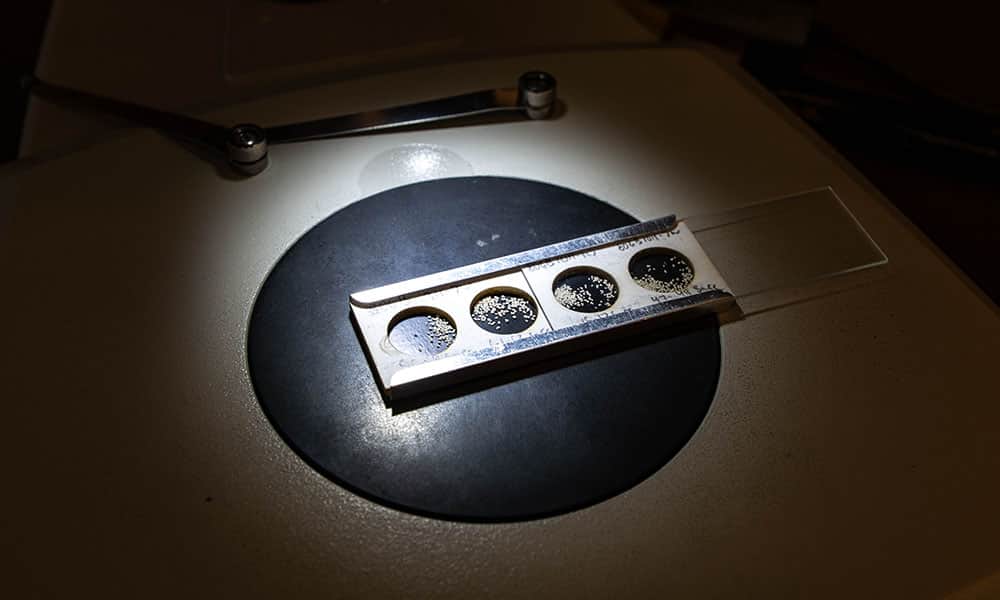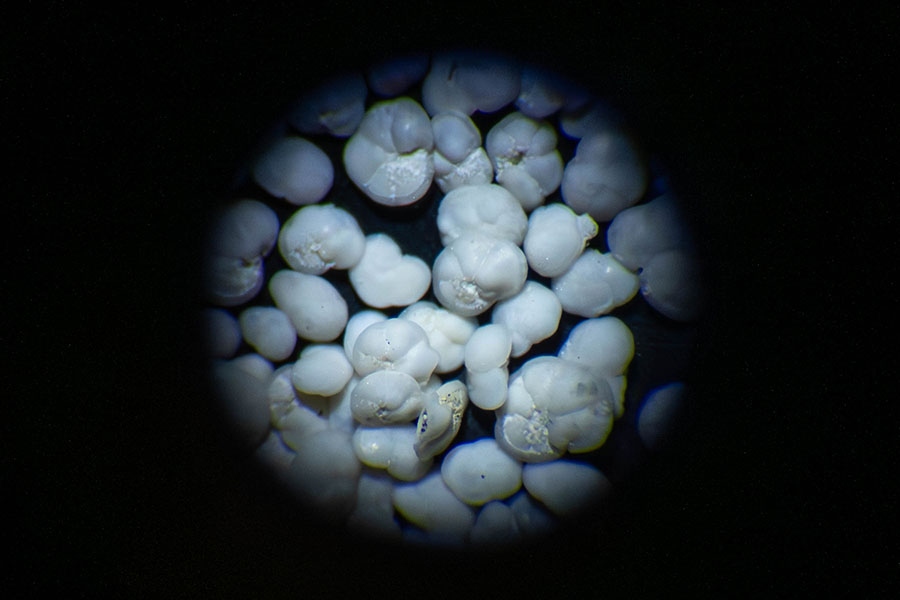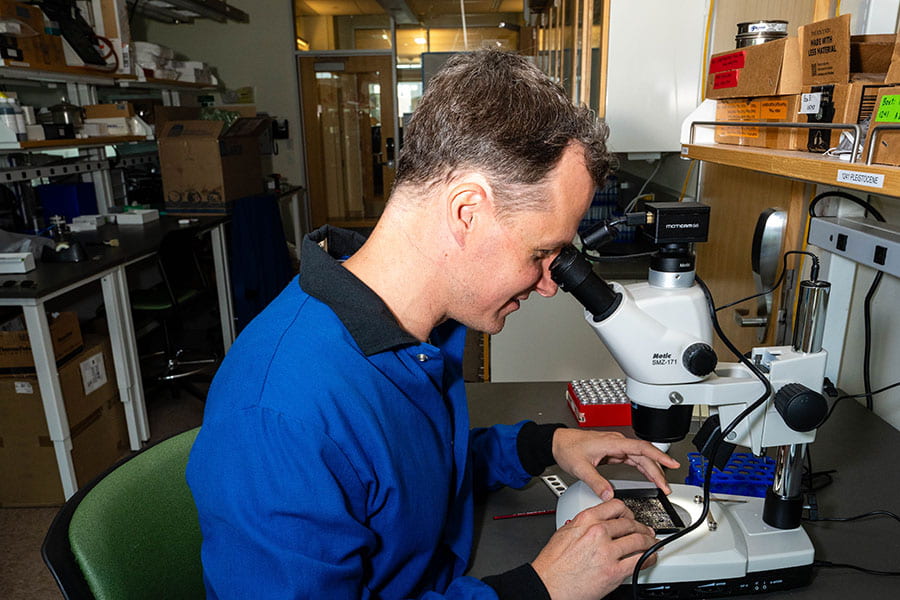- Home
- News
- Recent News
- Nitrogen In Fossils Indicates Climate Resilience in Pacific Ocean Upwelling
Nitrogen In Fossils Indicates Climate Resilience in Pacific Ocean Upwelling
By studying the shells of ancient plankton, Jesse Farmer and his colleagues have explored the state of the tropical Pacific during the warm Pliocene Epoch. Their study, published this week in the journal Science, shows that, counter to prior claims of permanent El Niño under a warmer climate, the nutrient upwelling that sustains fisheries in modern times was also strong in the Pliocene when the climate was warmer.

Across the eastern and central Pacific Ocean, near the equator, westward-blowing winds drive upwelling that pulls nutrients to the surface of the sea, up from the cold depths. This “cold tongue,” a tendril of chilled water along the equator, begins off the coast of Central and South America, and stretches westward as it reaches towards the shores of Asia. The nutrients in the cold tongue feed surface plankton—which, in turn, form the base of a mighty food web that includes some of the Americas’ largest fisheries.
However, when the sea becomes unusually warm, as it does in periodic climate events known as El Niño, the temperature gradient of the cold tongue vanishes… along with its nutrients. As a result, in El Niño years, the fisheries yield fewer fish. Some ocean researchers have suggested that, as the global climate warms, El Niño-like conditions may become more common, and these vital fisheries could completely collapse.
Luckily, a new study suggests a more hopeful future for the nutrient upwelling in the eastern Pacific, along with the fisheries that it supports. Jesse Farmer, an assistant professor in the School for the Environment at the University of Massachusetts Boston, and his colleagues have reconstructed prehistoric ocean dynamics using data collected from seabed sediment, and from the shells of fossilized plankton. Their paper, which was published this week in Science, shows that, during the Pliocene Epoch, the cold tongue faded… but the nutrient upwelling continued.

The Pliocene, which lasted from 5.3 to 2.6 million years ago, is the closest ancient analogue to Earth’s near-future climate, which is rapidly warming due to human activities, most notably the burning of fossil fuels. On land, the Pliocene was the era of mammals like giant ground sloths, mastodons, and the early ancestors of humans. The seas were roughly three degrees Celsius warmer than today.
Mathematical models have suggested that, with this excess heat, the Pacific Ocean was fairly stagnant, with a weaker temperature gradient from east to west—and, presumably, less nutrient upwelling from the depths—leading to conditions that some researchers describe as a “permanent El Niño.” However, other research suggested that, despite the warm seas, plankton may have continued to thrive.
To investigate further, Farmer and his colleagues examined nitrogen isotope ratios in both Pliocene seabed sediment and the shells of certain types of plankton (called foraminifera) that accumulated in it. These analyses in deep sea sediment cores record the long-term history of nutrient concentrations in the equatorial Pacific cold tongue.
“Analyzing nitrogen isotopes in foraminifera has allowed us to reconstruct the past with precision,” said Patrick Rafter, co-lead author of the study and a chemical oceanographer at the University of South Florida’s College of Marine Science. “We can compare these past conditions to today and make better predictions about the future. The methods we’ve used represent a big step forward in improving our predictive capabilities.”
Under a microscope, foraminifera shells look like shiny pieces of popcorn, but to the naked eye, they are hard to distinguish from grains of sand. To separate the shells from the surrounding silt, students at UMass Boston, University of South Florida, UC Irvine, and Princeton painstakingly sorted through the samples, using paintbrushes to isolate the largest shells. The work can be tedious, but without it, this research could not have been possible. The project first began in the lab of Daniel Sigman, the Dusenbury Professor of Geological and Geophysical Sciences at Princeton University, where Farmer was a post-doctoral researcher.
The researchers then chemically analyzed the shells and sediment to determine the samples’ nitrogen isotope ratio. This, in turn, reveals information about the concentration of nitrate near the ocean’s surface at the time when the foraminifera lived. Nitrate is a key nutrient for phytoplankton. The new measurements show that, even during the warm Pliocene, the upwelling of nitrate to the surface did not stop.

Farmer cautions that the conditions of the warm Pliocene period cannot be assumed to perfectly reflect what will happen over the next century. “Most importantly, our current warming is happening so quickly that the ocean may behave differently than it does when it’s been warm for a long time, as was the case in the Pliocene,” says Farmer. He points out that modern fisheries also face other threats, from ocean acidification to overfishing. Nonetheless, Farmer does derive some hope from his findings: “It’s good news that the nutrient supply to the eastern Pacific food web should be maintained in a warmer ocean.”
Going forward, Farmer and his colleagues will reconstruct other aspects of the global environment during the warm Pliocene, to better predict our planet’s future. “In addition to modern observations, in addition to climate modeling, we have this broad landscape of Earth’s history to work with.”